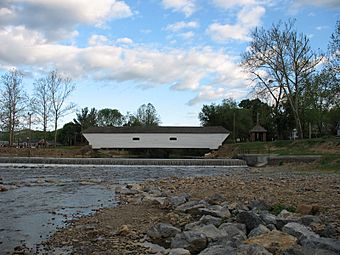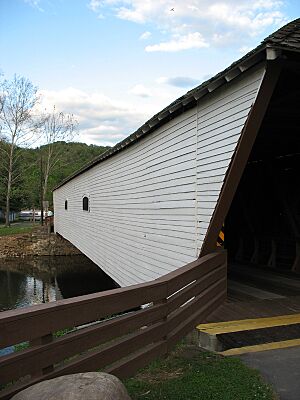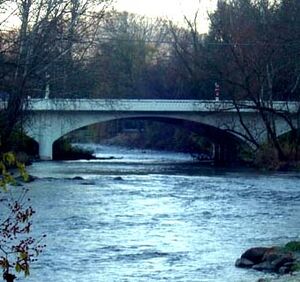Elizabethton Covered Bridge facts for kids
Quick facts for kids |
|
|
Elizabethton Covered Bridge
|
|
|
U.S. Historic district
Contributing property |
|
 |
|
| Lua error in Module:Location_map at line 420: attempt to index field 'wikibase' (a nil value). | |
| Location | Doe River at Elizabethton |
|---|---|
| Area | 62 acres (25 ha) |
| Built | 1882 |
| Part of | Elizabethton Historic District (ID73001754) |
| Added to NRHP | March 14, 1973 |
The Elizabethton Covered Bridge is a 134-foot (41 m) covered bridge that crosses the Doe River in Elizabethton, Tennessee. This town is the main city of Carter County.
This historic bridge was built in 1882. It connects 3rd Street and Hattie Avenue in Elizabethton.
Contents
What Makes the Bridge Special?
The Elizabethton Covered Bridge is a single-span bridge. It uses a special design called a Howe Truss. This design is made of strong wooden beams and iron rods. The main part of the bridge is 137 feet (42 m) long. The total length, including the ends, is 154.3 feet (47.0 m).
The bridge has one lane for traffic and a walkway for people. It is 16.4 feet (5.0 m) wide from curb to curb. The total width is 20.4 feet (6.2 m). The base of the bridge is made of stone and concrete. Each end of the bridge has a unique, pointy roof design.
Today, the Elizabethton Covered Bridge is closed to cars and trucks. But it's still a great place for people to walk or ride bikes across the Doe River.
History: The "Five Dollar Bridge"
Elizabethton grew a lot in the 1800s. But the town had a problem: the Doe River often flooded and blocked growth to the south. To expand west, where downtown is now, they needed a bridge.
In 1882, the county leaders agreed to spend $3,000 for the bridge and $300 for the paths leading to it. They chose a committee to pick the best spot. But there was a big problem: they couldn't find anyone to build the bridge!
Since no one else would take the job, a local doctor named E.E. Hunter stepped up. He agreed to be the contractor. Dr. Hunter then hired experienced people to help him build it. He chose Thomas Matson, an engineer who had worked on the "Tweetsie Railroad." Dr. Hunter often called it his "five dollar bridge." This was because he made a small profit of $5 as the contractor.
In 1901, a huge flood hit the area. Logs and even a barn crashed into the covered bridge. But guess what? The Elizabethton Covered Bridge was the only major bridge in the area to survive! This shows how strong it was built.
Fun Events at the Bridge
The Doe River starts on Roan Mountain. It flows past Elizabethton and under the historic covered bridge. Even though cars can't use it, the bridge is open all year for walkers and bikers.
The Elizabethton Covered Bridge is right next to a big city park. This park has walking trails, baseball fields, and picnic spots. The bridge connects this fun park area to the downtown business district of Elizabethton.
Most of Elizabethton's downtown area is listed on the National Register of Historic Places. This means it's important for its history and cool old buildings. The Elizabethton Covered Bridge is a very important landmark in the state. It was built before many of the downtown buildings that came with the "rayon boom" in the 1920s.
Every June, Elizabethton celebrates with the "Elizabethton Covered Bridge Days." This festival happens downtown and features country and gospel music. There are also activities for kids, a car show, and lots of food and craft vendors. The Elizabethton Covered Bridge is also part of the route for the yearly July 4th and Christmas parades.
How to Get to the Bridge
If you're coming by car, here's how to find the Elizabethton Covered Bridge:
- Take Interstate 26 to Exit 24 in Johnson City.
- Then, head east on US 321/Tennessee State Route 67 towards Elizabethton.
- Once you're in Elizabethton, stay straight on Elk Avenue to reach the downtown area.
![]()
![]()
![]() Interstate 26 Exit 24 at Johnson City then east
Interstate 26 Exit 24 at Johnson City then east
![]()
![]()
![]() US 321/Tennessee State Route 67 to Elizabethton, then
US 321/Tennessee State Route 67 to Elizabethton, then
straight on Elk Avenue to downtown business district.



